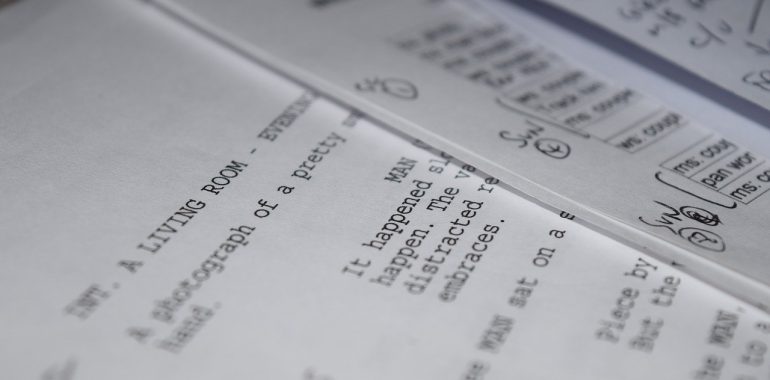Write the Script of Your Manga Story

Write the Script of Your Manga Story
Writing the script of a manga story is the last step before starting the drawing phase. Its purpose is to flesh out the details of the story and to add the key storytelling ingredients that will help keeping the readers attention.
What is a manga story script
A manga story script is a detailed page by page description of the content of the manga story or chapter.
Its first objective is to flesh out the outline of the manga story. This includes detailing the settings, the characters actions and emotions and the dialogues.
The second purpose of the script is to ensure a proper flow to the story and of the plot over the pages of the manga.
And all this while including the key storytelling techniques that will make the manga exciting for the readers.
Example
Here is a quick example how the script for the story in the article on building a manga story outline.
The first point in the outline is the following one:
The young boy is on a boat, travelling with his parents.
While being alone at night watching stars, he fells over board.
When he wakes up, he is on the shore of an unknown island.
This is how this point could be scripted in a first iteration:
Page 1
The boy is on the deck of a boat with his parents, the night is falling and the moon is already high in the sky.
Page 2-3
The boy — When do we arrive?
His Mother — Tomorrow, at about noon, we still have a long way to go.
The boy — That’s so long…
His Father — Sure, but we had great holidays!
The boy smiles.
The boy — Yes, that was great!
His Mother — It’s late now, let’s go to back to the cabin.
The boy — I’ll have a look at the stars.
His Mother — Alright, but don’t be late.
His Father — See you son!
Pages 4-5
The parents leave, letting the boy alone on the deck. The boy observes the starry sky, and then the reflection of the moon on the surface of the sea. He escalates the rail guard to have a better view and stays there, the boat going up and down with the waves. Feeling tired, the boy starts to yawn. Suddenly, he dozes off, he quickly wakes up but his hand slips and he drops over the rail guard, hitting his head and falling into the sea.
Page 6
The boy opens his eyes on a sandy beach, the sun already high in the sky…
Why should I write a script for the story of my manga?
Writing a script can seem tedious. But the key point here is really to prepare the content of your pages, without having yet to bother with the page layout. You want to make sure that you story flows properly and that your plot progresses at a good pace. The purpose is therefore to detail the content and to fit it into pages, paying attention to transitions between turn pages. These transitions are what makes it exciting to turn a page if you don’t know what surprise is waiting for you.
You could surely achieve the same result by mocking up your pages. But having to move content from one page to another might be a bit more complicated than just adding, moving or deleting some text.
And again don’t go directly to sketching your pages, as it will be even more complex to revise your content if you spot things that do not fit. And publishing chapters without having an idea of what will come next will quite surely lead to a failure. At best your manga story will be inconsistent, but you might end with unacceptable incoherences or lengthy useless content.
Writing the script of your manga story
Writing the script of your manga story is therefore basically going into the details of your outline.
Identifying scenes
Your first step will be to identify the different scenes of your story. A scene will generally be a set of events happening in a specific setting.
You might have a scene spanning over multiple chapters, as well as multiple scenes in a chapter.
For instance, you can have a complete chapter composed of a single scene with a boat pursuit on a canal. Or you can have a chapter composed of a sequence of scenes: a ride in a forest, the arrival at a town, the arrival at the inn, the characters shopping in the streets…
Scripting the scenes of your manga
For each scene, you will then describe the following elements.
To introduce the scene:
- the setting,
- the atmosphere,
- the characters which are present
As the scene unrolls:
- The changes of atmosphere,
- which characters go out of the scene or come in,
- what the characters are doing, saying or thinking,
- which emotions the characters are showing.
Overall, you should provide the minimum material required to draw the story.
You can have a look at the example I gave above. The first scene spans from page 1 to page 3. The second scene pages 4 and 5. and a third start and page 6.
Getting rid of the unnecessary content
For every sentence you write in the script of your manga, you should ask yourself:
“Is this useful for the progress of my story?“
If the answer is “no”, even though it could be nice if you had it, remove it.
If you think this might be useful, remove it.
Even more, if you have to twist your story to make it fit, remove it.
And finally, if this is here to fill some pages, remove it.
It is better for you to have a shorter but consistent and interesting story than a longer story where your readers will lose track and quit.
Of course, this doesn’t forbid you from adding a few nice to have elements from time to time (once every chapter or two); But the objective is to get rid of the mass of unnecessary elements.
Defining the content of the pages
Then, you should identify the boundaries between the pages.
As a general rule of thumb, manga pages have between 3 an 6 panels, which means between 3 and 6 locations / actions / pieces of dialogue / emotions shown.
The main focus should be to manage surprise and expectation from readers. Make them be eager to turn the page. An unknown character is arriving? Let the reader get aware of it on one page, and have him/her turn the page to discover the character. In the example I gave above, the boy falls into the sea end of page 5, leading the reader to turn the page to see if the boy will survive. It might not be possible to do that every two pages, but you should try to make it as often as possible to keep your readers thrilled.
You shall also identify key milestones of your story that will lead to a full page or a double page drawing. This will generally be the introduction of a new character, an intense moment of a fight, the discovery of a city after days of travel…
This part will require a bit of practice, but getting the feeling of what content fits or does not fit in one page should come quickly. Write your script, build a mockup of your pages on that basis to see what it gives in terms of panels… and go back to the script if you see this does not fit as expected. And re-iterate until you have something satisfying.
Control the pace of your story
As stated in my article on writing the outline of your manga story, an element of your outline should be between a few pages and one or two chapters.
This means that at the end of a chapter, or within the next one, your characters should be closer to their destination. Your characters should either have learned or gained something that will help them, or something that will make things more complicated.
This is like for instance going the wrong direction but finding an important information. Or arriving in a temple where a key item for your journey should be hidden, and finding out it has been stolen.
If you don’t ensure progress along your chapters, your story will look flat and un interesting. It is better to shorten a battle and make the few moves epic, than having a hundred pages of battle letting your readers clueless.
Managing expectations between chapters
Keeping the readers eager to read your next chapter is also essential. Therefore as you might try to keep interest of the readers between turn pages, you should also try to keep that interest between chapters.
Make it so that your chapters end with an open question. This can be a shadow that surprises the characters, and makes the reader wonder who this is. A character receiving a letter and the reader expecting the content. Characters ready to punch each others and the reader expecting to see the winner. Or a great reveal that makes the reader wonder how this will change the story.
The objective of this is to create thrill and tension in order to trigger emotions and expectations in the readers mind.
Conclusion
As a conclusion I would recommend you to script your manga story. The script will give you a good control on the flow of your story and on how you keep the attention of your readers.
Do not hesitate to re-read your favourite manga to see how these rules are applied. Have a look at both manga you liked and manga you disliked. And look if what made you like or dislike these manga is the way the pace and expectations are set, or the way the story progresses.
Now that you have your script ready, discover how to prepare your panels with my article on manga panelling basics!
This is it for this article. I hope you found it useful. Do not hesitate to like and share, and do not hesitate to comment and ask questions.
See you!
Stef
